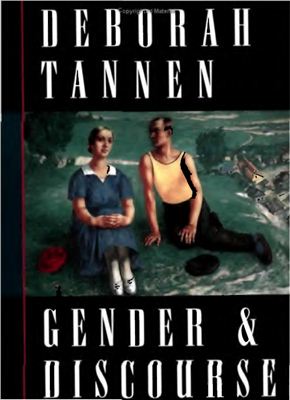6 illuminating scholarly essays on language and gender. An absolute
must-have for all language scientists.
Linguistics professor Tannen (You Just Don't Understand: Women and Men in Conversation, LJ 4/1/92) presents five previously published theoretical essays, each revised and introduced for the specialist and accompanied by notes and references. An introduction describes her research methods and conflicts surrounding interdisciplinary gender studies. Included is a study that was crucial in motivating her to study gender and language further. This is not a mere working over of earlier papers but a useful thematic compilation for larger public and all academic libraries.
Helen Rippier Wheeler, formerly with the Univ. of Califoia at Berkeley, SLIS
In attempt to defend and expand upon her theories of miscommunication between men and women, sociolinguist Tannen provides the scholarly underpinnings of her 1990 bestseller, You Just Don't Understand. The material included in these five previously published and ponderous essays differs from Tannen's earlier book primarily in that it is addressed to a jury of her academic peers. Jargon abounds throughout, from terms like ``kinesic/proxemic analogue'' to ``the polysemy of power and solidarity. '' However, the central ideas are quite familiar: Pervasive miscommunication between men and women is due, in large part, to a complex set of ``cross- cultural'' and stylistic differences; though men do tend to dominate women in society, their domination of women in conversation is not necessarily bo of an intent to dominate; linguistic strategies (such as interruption) can mean different things in different instances; and understanding style differences allows for adjustments without casting blame on either gender. Also repeated are many of the studies and examples Tannen cites elsewhere (Marianne and Johan's conversational strategies in Ingmar Bergman's Scenes From a Marriage; videotaped dialogues between eight pairs of same-sex friends). Tannen is at her most interesting (and original) in the introduction, in which she elaborately defends her own ``culture difference theory and research. '' Responding primarily to her scholarly critics who see gender and language according to models of power and dominance, rather than cultural differences, she insists that one does not preclude the other. Though she does not convince so much as pique interest in the debates raging in her field, this is one of the book's more compelling sections. This may offer intrepid Tannen fans or academicians worthy bits of information and insight, but general readers are likely to find little reward in this dense tome. --
Linguistics professor Tannen (You Just Don't Understand: Women and Men in Conversation, LJ 4/1/92) presents five previously published theoretical essays, each revised and introduced for the specialist and accompanied by notes and references. An introduction describes her research methods and conflicts surrounding interdisciplinary gender studies. Included is a study that was crucial in motivating her to study gender and language further. This is not a mere working over of earlier papers but a useful thematic compilation for larger public and all academic libraries.
Helen Rippier Wheeler, formerly with the Univ. of Califoia at Berkeley, SLIS
In attempt to defend and expand upon her theories of miscommunication between men and women, sociolinguist Tannen provides the scholarly underpinnings of her 1990 bestseller, You Just Don't Understand. The material included in these five previously published and ponderous essays differs from Tannen's earlier book primarily in that it is addressed to a jury of her academic peers. Jargon abounds throughout, from terms like ``kinesic/proxemic analogue'' to ``the polysemy of power and solidarity. '' However, the central ideas are quite familiar: Pervasive miscommunication between men and women is due, in large part, to a complex set of ``cross- cultural'' and stylistic differences; though men do tend to dominate women in society, their domination of women in conversation is not necessarily bo of an intent to dominate; linguistic strategies (such as interruption) can mean different things in different instances; and understanding style differences allows for adjustments without casting blame on either gender. Also repeated are many of the studies and examples Tannen cites elsewhere (Marianne and Johan's conversational strategies in Ingmar Bergman's Scenes From a Marriage; videotaped dialogues between eight pairs of same-sex friends). Tannen is at her most interesting (and original) in the introduction, in which she elaborately defends her own ``culture difference theory and research. '' Responding primarily to her scholarly critics who see gender and language according to models of power and dominance, rather than cultural differences, she insists that one does not preclude the other. Though she does not convince so much as pique interest in the debates raging in her field, this is one of the book's more compelling sections. This may offer intrepid Tannen fans or academicians worthy bits of information and insight, but general readers are likely to find little reward in this dense tome. --

